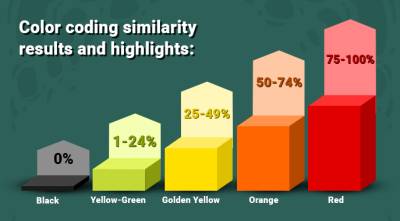This is an old revision of the document!
Interpreting mLaP Results
Is this piece plagiarized? mLaP provides the information that helps the teacher determine whether a submitted piece has been plagiarized. It comes in a form of percentages of similarities, ranging from 0 to 100%.

Then mLaP highlights the parts showing the matches. The orange highlight, for instance, is for 50 to 74% similarities.
Readability
To add contextual data that may be used to further interpret the submitted document for mLaP scanning, readability scores are appended. These scores are based on the average length of sentences and words in the document. With a score of 60 on Flesch reading-ease, for instance, a document will be easy to read for most people with at least an 8th-grade education (or about a 13-year-old in the U.S. grade levels). The higher the score on Flesch reading-ease, the more readable the document is.
So, the relevant question in relation to plagiarism might be, is this particular document submission consistent with the readability of the submitter's previous submissions? Is the piece's readability related to the readability of its sources (Roig 2001; Sun 2012; Torres & Roig 2005)? In one study, for example, “incidences of potential plagiarism such as exact copying and near copying appeared to be higher for the low-readability text (33%) than the high-readability text (11.2%)” (Sun 2012: 302). Did the document submitters simply use paraphrasing tools (like this and that) mechanically without making the texts truly “their own”?
Which Readability Test?
Flesch tests are multi-disciplinary and a good starting point. Technical writers may refer to Automated Readability Index. For business, you may also check out Gunning Fog Index. Medical and healthcare fields gravitate towards Coleman Liau Index and SMOG Index.
References
Roig, M. (2001). Plagiarism and Paraphrasing Criteria of College and University Professors. Ethics & Behavior, 11(3), 307–323. https://doi.org/10.1207/S15327019EB1103_8
Shi, L., Fazel, I., & Kowkabi, N. (2018). Paraphrasing to transform knowledge in advanced graduate student writing. English for Specific Purposes, 51, 31–44. https://doi.org/10.1016/j.esp.2018.03.001
Sun, Y.-C. (2012). Does Text Readability Matter? A Study of Paraphrasing and Plagiarism in English as a Foreign Language Writing Context. Asia-Pacific Education Researcher, 21, 296–306.
Torres, M., & Roig, M. (2005). The Cloze Procedure as a Test of Plagiarism: The Influence of Text Readability. The Journal of Psychology, 139(3), 221–232. https://doi.org/10.3200/JRLP.139.3.221-232